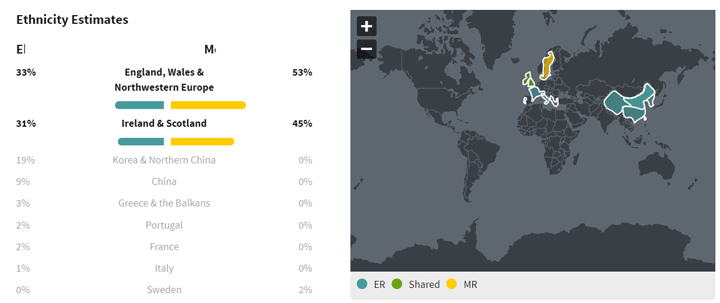The DNA results are in and they confirm that we have found the sperm donor, my late husband’s second cousin once removed. This cousin now has 8 children instead of none. Back then, donors were promised anonymity, but DNA testing has changed that; if their close family or cousins have done DNA testing, then it is likely that they can be identified. Continue reading
Tag Archive | Adoption Success Stories
Can Y DNA Solve an Unknown Parentage Case?
Sometimes testing the Y chromosome can help when you are looking for a missing father, grandfather, or further back as long as you have a tester descended on the male only line. Remember the Y is passed father to son, so any changes are rare and are caused by mutations not recombination. Typically a man would start with a Y 37 STR marker test at Family Tree DNA to see if this avenue is worth pursuing. A STR test gets the most recent changes rather than the haplogroup, thus can suggest a surname. Click here for my article explaining Y testing.
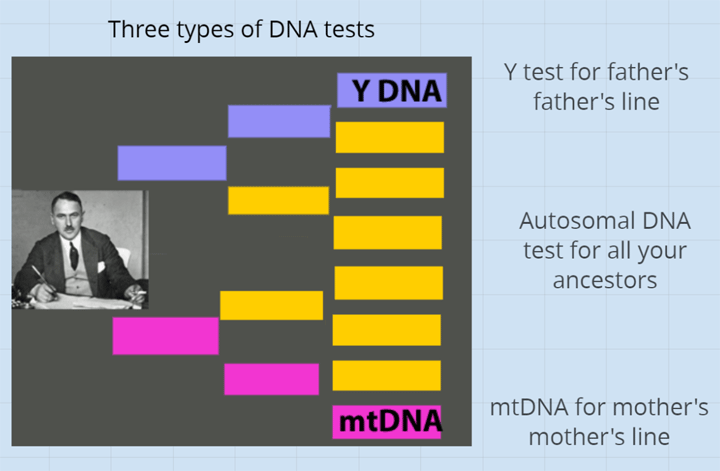
Slide from my 2017 talk on DNA testing for genealogists featuring my maternal grandad
The Y results will not help if no other men from that Y lineage have tested unless you have a theory. In that case you need to test someone else descended on the male only line from the presumed ancestor.
Y testing can be very useful when the unknown parentage occured many generations ago, such that autosomal testing may not be able to solve it.
If your ancestors have been in the USA for some time then a Y 37 STR marker test may find a probable last name. In that case there may be a surname project with other Y testers at Family Tree DNA. I recommend contacting the admins of that project as they can often be a great help in your quest. However if you are from a population group which has only had inherited surnames for two hundred years or less, quite likely you will have no luck.
Continue reading
Automated Tree Building with Genetic Affairs
Clustering has changed the way many of us work on genealogy mysteries and unknown parentage cases. Genetic Affairs was just one of the sites offering automated clustering (click here for my first clustering post), but then they added tree building. That’s right, they make tree diagrams for each cluster that has at least two people with trees that can be matched up. They even include a GEDcom for those trees in the zip file they send.
One way I use these diagrams is to show cousins how we are related. Another way I use this feature, is to solve unknown parentage cases. I use both DNA2tree and Genetic Affairs and then go with whichever seems to have the more relevant looking trees. The advantage of Genetic Affairs (GA) is that it will look at the unlinked trees and at your ThruLines. Also the output is easy to glance over to see what is worth pursuing, once you are used to the format. Click here for my recent post on automated tree-building tools.
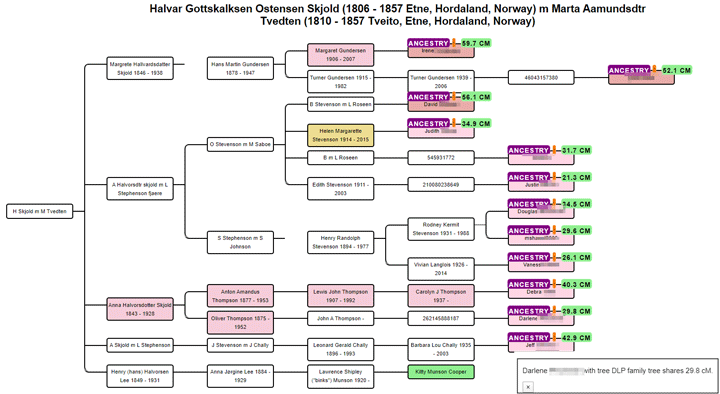
Above is the diagram GA built for the descendants of my gg-grandparents who are in the lonely box on the far left. Click on the image for a larger image in a new tab. My great grandparents lived on farm Skjold in Etne, Hordaland, Norway and had eight children, four of whom, plus the child of another, emigrated to the USA and have many tested descendants at Ancestry.
Here is a key to what you are seeing. The green box on the bottom line is me. The mustard yellow box means that the match’s unlinked tree was used from that person on down. The people in pink in the middle were determined from my ThruLines. Living people are shown as just id numbers, except for your matches who are shown by the name they have chosen to be seen as. All DNA matches are on the far right and are also colored pink with the source and the amount shared listed. Clicking on a match gets a little box to pop up in the lower right corner (as shown) with the name of their family tree, clickable to their Ancestry tree.
UPDATE 24 Jun 2020: Clustering on Ancestry is no longer available as they issued a cease and desist order to Genetic Affairs and many other 3rd party sites. Please click here and send a suggestion to Ancestry that they implement clustering on their site.
The purple box with the word ANCESTRY indicates the source of the tree information. Another GA feature is the ability to cluster both your Family Tree DNA matches and your Ancestry matches together.
When names are listed differently in other trees they will be shown in these diagrams as separate people. Notice that in the second from the left column, that the software could not tell that the A. Skjold who married L. Stephenson is the same person as the A. Halvorsdtr skjold who married L. Stephenson Fjaere. Norwegians did not have fixed surnames so we usually use the farm name as a surname in our trees. Often upon arriving in this country they often chose to use the patronymic, so Stephenson rather than Fjaere (click here for more on Norwegian naming). However the other Anna Halvorsdtr Skjold listed between those two really is a different person and she married a Thompson. Reusing first names is another bane of the Norwegian genealogist.
This tree building capability from Genetic Affairs recently helped me solve an unknown father mystery.
When “Amy” discovered her brother was only a half brother by doing an Ancestry DNA test, she was very surprised. She had heard that her mother was pregnant with her when marrying her late father, but everyone knew he was her Dad, or so she thought. Her mother was not willing to discuss this, so she asked for my help to figure out her biological father from the DNA.
Continue reading
Upcoming talks, i4GG, and a case solved using the latest DNA tools
Unknown parentage searches have changed dramatically over the last year thanks to a number of great new automated tools. I 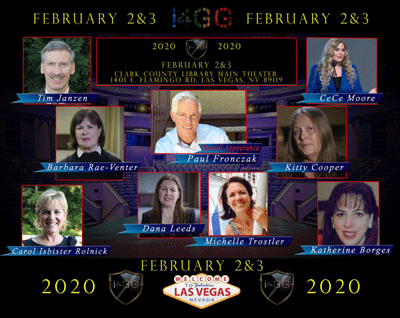 will be updating my presentation on this for the upcoming i4GG conference in Las Vegas in a few weeks, the first weekend in February. I will also probably talk about what’s new at GEDmatch as well as be on a panel there.
will be updating my presentation on this for the upcoming i4GG conference in Las Vegas in a few weeks, the first weekend in February. I will also probably talk about what’s new at GEDmatch as well as be on a panel there.
Plus I will present how to use these new wonderful tools to explore your cousin matches at the North County DIG meeting next Saturday, January 18.
Below is a screen shot of the final slide in my unknown parentage presentation where I list the steps, in order, that I currently go through on these searches. I need to add at the beginning another step, “check the ethnicity,” as it can be a huge clue when the two parents are descended from very different populations. Click here for a recent blog post on a case solved with ethnicity. Also I have found that the listed communities at Ancestry are pretty accurate so they can be quite useful too.
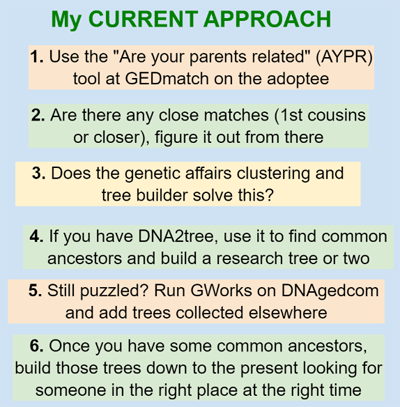
Finding an unknown father in a few hours with DNA has become much more common due to the large number of American testers. A neighbor, let’s call her Dede, noticed I was a genealogist on FaceBook, so contacted me for help late one evening in December. She asked if I could help figure out who her unknown Dad was from her DNA results. She was a bit discouraged because no one had answered her messages.
Dede was tested on Ancestry and although her mother was not tested, a known maternal first cousin happened to be in her match list. That would be useful for separating the maternal from the paternal matches. Dede’s ethnicity had a surprisingly high 47% German percentage while her first cousin had only 27% . Plus that cousin had no Eastern Europe (Dede 10%) or Baltic (Dede 3%) so perhaps Dede’s father was part Germanic and Slavic.
Dede’s ethnicity at Ancestry – note the Kentucky community
I took a quick look at her Ancestry match list and saw several paternal 2nd and 3rd cousin matches so I told her that it would be pretty easy, then quoted her my discount rates and a estimate. The next day I sent her the wedding picture of her father’s parents. She and her family drove to Oregon after Christmas to get to know her half sister and Dad. What a magical Holiday it was for all!
Continue reading
Can ethnicity help with unknown parentage?
Recently ethnicity was a major factor in figuring out the family of the mystery father of an Australian women of mixed heritage: Chinese, Italian, and English/Irish.[UPDATE 4-APR-2020: no help needed, all resolved now.]We still need some help, so any Australian readers please read to the end.
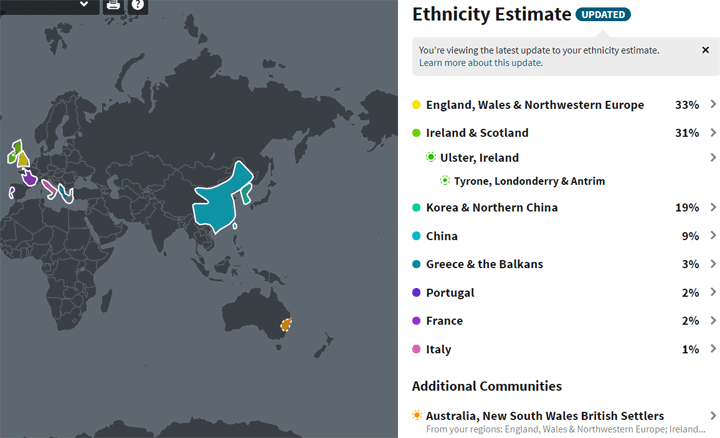
Elana’s ethnicty on Ancestry after the update, before she had lots more Italian
This case is unusual because for those of us with primarily European ancestry, the ethnicity predictions from the various DNA test companies are not accurate enough to be a significant aid with figuring out unknown parentage situations. For one thing, our ancestors moved around more than you might expect, and for another, the science is just not exact enough yet.
Too often I get a panicked email or comment from someone who is worried that Daddy is not their dad, or perhaps grandad is not, because their ethnicity predictions show no German or French or Bulgarian which he was and where is that Norwegian from? To which I respond, check your matches, if you have matches to cousins from his family, all is well, it’s just the inaccuracy of ethnicity predictions. North Europeans and South Europeans are fairly distinct from each other, but countries as we know them today did not exist in the far past.
In Elana’s case, having East Asian and Southern European in addition to the usual Australian British mix, actually gave us some different and potentially useful data to work with. Her mother seemed entirely English, Welsh, Scottish and Irish, a frequent blend for an Australian. She remembers that Elana’s father said he was part Maori and that his name was Bob. There is no Maori in her results shown above (it usually looks Polynesian), so likely he was just trying to make himself seem exotic and interesting.
Since Elana’s mother tested also, we could see that Elana had no close matches that were not listed as “Mother’s side” on Ancestry which made the search very difficult. Her paternal matches consisted of only one 3rd cousin, an American of Italian ancestry, and lots of 4th cousins, quite a few with trees, and most of the closer ones were of Italian descent, in spite of only 7% Italian listed in her Ancestry ethnicity.
One possibility for so few paternal matches was related parents. We checked that by uploading to GEDmatch.com (click here for my post on related parents) and that was not the case. The other more likely explanation was very few of her father’s relatives had tested. For example, Elana had only one very distant Asian match in spite of her father clearly having half that heritage.
Since we could see both Elana’s ethnicity and her mother’s it was easy to tell that Elana’s unknown father was half Chinese/Korean with an Italian (great) grandparent. These were her initial percentages before the recent update at Ancestry:
65% England/Scotland/Wales (so her father will have about 15%)
16% Korea and Northern China
12% China
7% Italy
I asked Elana to also test at 23andme and to upload her Ancestry results to MyHeritage and Family Tree DNA as well. Still no luck finding close paternal matches.
